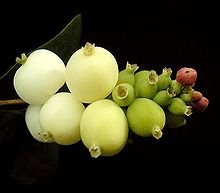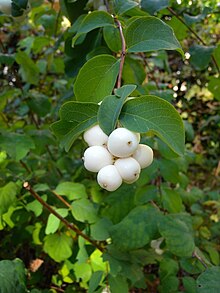Common snowberry
| Common snowberry | ||||||||||||
|---|---|---|---|---|---|---|---|---|---|---|---|---|

Inflorescence of a common snowberry ( Symphoricarpos albus ) |
||||||||||||
| Systematics | ||||||||||||
|
||||||||||||
| Scientific name | ||||||||||||
| Symphoricarpos albus | ||||||||||||
| ( L. ) SFBlake |
The common snowberry ( Symphoricarpos albus ) is a shrub native to North America that is widespread in Europe as an ornamental wood. The white fruits remain on the bushes into winter. Because of the noise the fruits make when they are crushed, they are also called snap peas .
features
The common snowberry is a deciduous shrub and reaches heights of 0.3 to 2 m. It forms a large number of slender, two to 2.5 cm thick, slightly overhanging branches. The branching occurs basiton (at the base of the shrub). The plants form underground stem cuttings foothills , which run a few centimeters below the surface and up to 60 cm long are. The shoots grow up at the ends. New runners are only formed when the sapling has established itself. The trunks have adventitious roots up to a height of 100 cm , which are functionless on standing branches, but lead to rooting and thus to the establishment of new plants when broken, lying branches. The winter buds have two pairs of outer bud scales.
The bark of young branches is smooth and yellowish-gray, later it becomes darker and scaly. Calcium oxalate drusen occur in the bast parenchyma. The wood is ring-pored, the wood parenchyma is irregularly distributed between the fibers. The fibers themselves have spiral wall thickenings.
The leaves are opposite, but their position appears two-lined when the petioles turn. They have a short petiole , are simple, entire and dull green. The length is 4 to 6 cm, the leaf shape is egg-shaped to rounded, the leaves are slightly pointed at the end and rounded at the base. The petiole is runny on the upper side, thickened at the base. The leaves on the young saplings have a different appearance: here they first become colorless lower leaves, then small, entire, stalked leaves, then large, lobed, sometimes coarsely toothed leaves in the central region, and then again small and entire leaves at the end of the shoot.
Flowers and fruits
The inflorescence is a multi-flowered, dense spike . Each inflorescence has several small, triangular bracts .
The flowers are radial symmetry, bell-shaped and five-fold. The chalice is bowl-shaped and five-toothed. The fused-leaf crown is reddish. The five stamens attach to the wall of the crown and stand here in a wreath of hair. There are several curved nectaries on the inside of the corolla tube . The ovary is inferior, has four compartments and contains two fertile ovules . Flowering time is June to September.
The fruits are white, almost spherical, juicy and have a diameter of 10 to 15 mm. The fruit is a two-pitted stone fruit, but is sometimes called a berry . They ripen between July and October and stay on the shrub until winter. In a berry there are two seeds that are around 5 mm long, elliptical, slightly compressed and have a hard seed coat. The pulp is spongy.
Chromosome number
For the chromosome numbers there is information about 2n = 36, 54 and 72, which would mean that there are tetraploid , hexaploid and octoploid clans .
ecology
The common snowberry is a shrub with no winter . Although its leaves are opposite to one another, their blades on horizontal and drooping branches are positioned horizontally for better use of light.
The flowers are homogamous "bluebells with sticky pollen ". The nectar is abundantly secreted by fairly large papillae on the inside of the corolla tube. There is also a drillable tissue. The flowers are visited by short to medium-nosed insects ( bees , wasps , hover flies ). The flowers are a pasture for bees, but self-pollination is also possible. Flowering time is June to September.
The fruits are white, berry-like stone fruits with mostly 2 solitary stone pits. The pulp is large and spongy; its whiteness comes about through total reflection of the light on the air-filled intercellular spaces. It finds a digestive spread u. a. held by thrushes and finches. Although the fruits are winter dwellers , they are rarely accepted as food.
The vegetative propagation takes place through underground creeping shoots, so the shrub can quickly form dense stands.
ingredients
The berries contain saponins and an unknown, strongly irritating active ingredient. They also contain the isoquinoline alkaloid chelidonine and other alkaloids .
Herbivores
The common snowberry is an important forage crop for various animal species in America, including bighorn sheep ( Ovis canadensis ) and white-tailed deer ( Odocoileus virginianus ). The fruits are eaten by different birds and small mammals, including the collar chicken and Tympanuchus phasianellus , turkeys ( Meleagris gallopavo ), Tyrannus , Western Bluebird ( Sialia mexicana ) and the mammalian fox squirrel ( Sciurus niger ), the cottontail rabbit audubonii Sylvilagus and pocket gophers (Geomyidae) .
Toxicity
There are different statements in the literature about the toxicity of berries for humans. The poison control center of the University of Bonn classifies the species as poisonous and gives diarrhea as a symptom . With small amounts (three to four berries) there are usually no symptoms, with larger amounts there are intestinal problems, fever and tiredness. There have also been reports of damage to the lining of the mouth and stomach.
Systematics
There are two varieties within the species :
- Symphoricarpos albus var. Laevigatus (Fern.) Blake is native to the western United States, its range extends from southern Alaska to California, Montana and Colorado. It is the most common variety in Europe. Their characteristics are those described above.
- Symphoricarpos albus var. Albus is more native to the east of North America, with around one meter smaller than laevigatus , also has fruits that are 10 mm smaller, the twigs and branches are hairy.
Older, sometimes rarely used synonyms for Symphoricarpos albus are Symphoricarpos racemosus Michx. and Symphoricarpos rivularis Suksdorf .
Distribution and locations
The common snowberry is native to North America. It occurs from Hudson Bay to Alaska , in the south to California and in an easterly direction to North Carolina . Here it grows in a large number of plant communities, mainly in warm and / or dry locations. Examples of climax vegetation in which the species is co-dominant are forests of yellow pine ( Pinus ponderosa ), Douglas fir ( Pseudotsuga menziesii ) and rocky fir ( Abies lasiocarpa ). It grows preferentially on the edges of the forest, also on river banks.
In Europe the species is widespread as an ornamental plant and is also naturalized in large parts, but is absent in the Mediterranean area. In the UK, it is practically nationwide. In Germany it is often found wild in the surroundings of settlements and cities and forms its own plant community , the Symphoricarpetum albi within the Sambuco-Salicion capreae association, a society that is also widespread in Great Britain. The species grows best in moist, but not waterlogged, fertile soils in full sunlight.
use
The Indians in Washington and Oregon ate the fruit fresh or dried and used it as a hair shampoo. Fruits and leaves were crushed and applied to wounds. A tea made from the bark has been used to treat tuberculosis and venereal diseases. Arrow shafts and pipe pipes were made from the wood. Today the species is often planted to restore disturbed locations.
In Europe, but also in North America, the common snowberry is often planted as an ornamental wood. In Great Britain it was also planted outside of settlement areas as a cover wood for birds and game.
history
The common snowberry was first made known in Europe by the Swedish botanist Pehr Kalm , who found the species in Pennsylvania in the mid-18th century . Through Kalm, Carl von Linné became aware of the species, but he erroneously called it Vaccinium album because of its similarity to the heather family ( Ericaceae ) . André Michaux put it as Symphoricarpos racemosus in the genus Symphoricarpos . In 1914, Sidney Fay Blake renamed it Symphoricarpos albus for nomenclature reasons .
From the 19th century the species was planted as an ornamental shrub in gardens in Europe. The laevigatus variety used as an ornamental plant was discovered by Lewis and Clarke in the Columbia River area. From the seeds they collected, Bernard McMahon grew plants in Philadelphia. The first seeds came to London in 1817 and were further distributed from here. From the middle of the 19th century the shrub was widespread in gardens, parks and cemeteries in Germany, especially since it is also a fertile bee pasture. The plant went wild in many cases from these locations. The berries are popular with children because they pop when they are trodden on (hence the name Knallerbsenstrauch).
The "Knallerbsenstrauch" was thematized by Stefan Raab in 1999 when he showed excerpts from the show "Judge Barbara Salesch " after a neighborhood dispute with Regina Zindler and used mesh-wire-fence in his song . The dispute was about the fact that a crackling pea bush in a garden extends into the neighboring property and should be removed.
supporting documents
The article is based on the following documents, unless supported by individual references:
- OL Gilbert: Symphoricarpos albus (L.) SF Blake (S. rivularis Suksd., S. racemosa Michaux) . In: Journal of Ecology . Volume 83, 1995, pp. 159-166.
- Peter Schütt, Ulla M. Lang: Symphoricarpos albus . In: Schütt, Weisgerber, Schuck, Lang, Stimm, Roloff: Encyclopedia of Bushes . Nikol, Hamburg 2006, pp. 373-378. ISBN 978-3-937872-40-7
- Ruprecht Düll , Herfried Kutzelnigg : Pocket dictionary of plants in Germany and neighboring countries. The most common Central European species in portrait. 7th, corrected and enlarged edition. Quelle & Meyer, Wiebelsheim 2011, ISBN 978-3-494-01424-1 .
Individual evidence
- ^ Peter Schütt, Ulla M. Lang: Symphoricarpos albus . In: Schütt, Weisgerber, Schuck, Lang, Stimm, Roloff: Encyclopedia of Bushes . Nikol, Hamburg 2006, p. 375. ISBN 978-3-937872-40-7
- ↑ a b L. Roth, M. Daunderer, K. Kormann: Toxic Plants, Plant Poisons . 4th edition, ecomed, Landsberg 1994, pp. 685f. (Reprint ISBN 3-933203-31-7 )
- ↑ Artinformaion the Canadian Poisonous Plant information system accessed 10 August, 2008.
- ↑ a b c Jack McWilliams: Symphoricarpos albus . In: Fire Effects Information System . US Department of Agriculture, Forest Service, Rocky Mountain Research Station, Fire Sciences Laboratory, 2000. Online resource , accessed August 10, 2000.
- ↑ Species information from the poison control center of the Univ. Bonn, accessed September 26, 2010.
- ↑ a b O. L. Gilbert: Symphoricarpos albus (L.) SF Blake (S. rivularis Suksd., S. racemosa Michaux) . In: Journal of Ecology . Volume 83, 1995, pp. 159-166.
- ↑ a b Heinz-Dieter Krausch : Kaiserkron and Peonies red ... From the discovery and introduction of our garden flowers . Deutscher Taschenbuch Verlag, Munich 2007, p. 452. ISBN 978-3-423-34412-8
- ↑ mdr.de: Once upon a time there was a crackling pea bush ... ( Memento from February 23, 2007 in the Internet Archive ) from August 5, 2005.
Web links
- Common snowberry. In: FloraWeb.de.
- Common snowberry . In: BiolFlor, the database of biological-ecological characteristics of the flora of Germany.
- Profile and distribution map for Bavaria . In: Botanical Information Hub of Bavaria .
- Symphoricarpos albus (L.) SF Blake In: Info Flora , the national data and information center for Swiss flora . Retrieved March 29, 2016.
- Thomas Meyer: Snowberry data sheet with identification key and photos at Flora-de: Flora von Deutschland (old name of the website: Flowers in Swabia )
- Plants for a future




